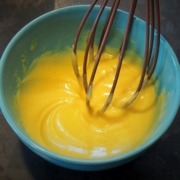Mayonnaise can seem so difficult to make and yet becomes so easy once you are fully aware of the tips and tricks and the different steps. Homemade mayonnaise is so tasty. You’ll never be able to eat that industrial stuff once you’ve tasted it!
Mayonnaise is the result of quite a complex chemical reaction. The egg yolk and mustard’s molecules have physical properties that can capture oil and enable all ingredients, even water, to link together to create a smooth mixture.
Here are the Dos and Don’ts:
- Use all ingredients at the same room temperature (eggs have to be taken out of the fridge at least 1 hour in advance)
- Be sure to add the ingredients in the proper order and the right way (see recipe)
- Although any oil works, grape seed oil is best
- For a tasty flavor, mix your preferred oil with olive oil
- Gradually add the oil in a very thin dash of oil while stirring vigorously
- Use a whisk (rather than a fork) and a round-bottomed bowl
Each family has their own recipe with different proportions.
Mayonnaise is eaten cold as a condiment for many dishes (salads and raw vegetables, fish and shellfish, cold meats, eggs…). The incontournable “œuf mayo” (hard boiled eggs with mayonnaise) is a must in Parisian bistros, to the point that there is even an institution, created by a culinary critic 25 years ago, devoted to the protection of the oeuf mayo, the Association de sauvegarde de l’œuf mayo. Every year, they have the tough job of selecting Paris’ best œuf mayo. Where once it was a cheap and popular house hold staple, from the beginning of the 20th century, it lost popularity, and is now back in society’s good books and is a must on bistro menus.
Mayonnaise is also the base for many other sauces such as remoulade, ravigote or aïloi. At home, we often make up recipes according to what’s in the pantry adding mayonnaise to many raw vegetable or leftovers such as tuna, cold beef…
The name mayonnaise have 3 different explanation
From East South France town Bayonne, or from the old French of egg yolk, or from the French verb manier (manipulate) as stirring is the clue to its success.
It’s called sauce française (French Sauce) in many foreign countries.

Homemade French Mayonnaise
Ingredients
- 1 egg yolk at room temperature
- 1 tea spoon mustard ideally French Dijon Mustard
- 1 cup oil ideally grapeseed oil, if not sunflower oil
- salt
- pepper
Instructions
- In a round bottom bowl, first mix the egg yolk and the mustard. Add salt and pepper.
- Then gradually pour the oil in a very thin and regular dash and keep stirring vigorously with a whisk. Make sure you don't drop the oil too quickly - if so stop adding oil and stir even more vigurously to incorporate the excess of oil - and don't stop stirring and pouring oil until you don't get a smooth aerated texture.
